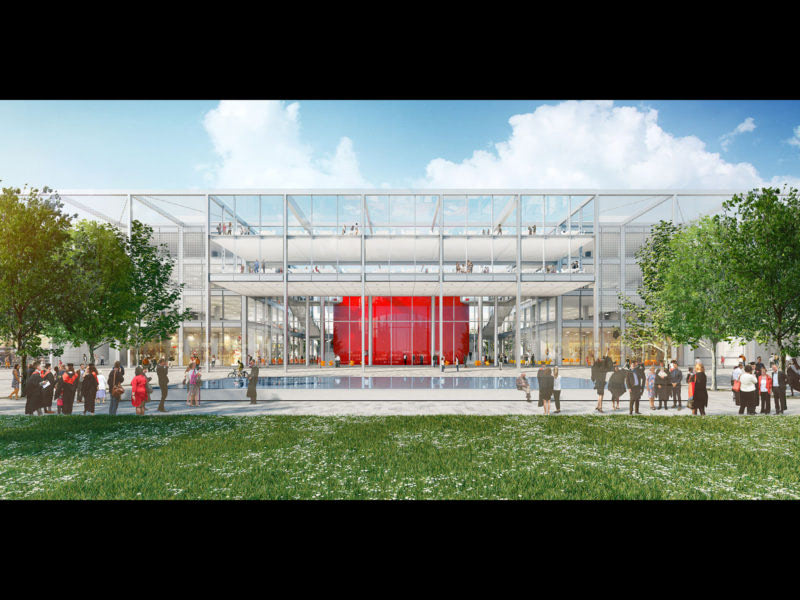Harvard University architects win competition to design Cranfield University’s MK:U

Hopkins Architects, the designers behind Harvard University’s new Smith Campus Center, as well as the London 2012 Velodrome and the award-winning WWF Living Planet Centre eco-building, have been chosen to create a 21st century university quarter for Milton Keynes.
MK:U is a partnership between Milton Keynes Council and Cranfield University, supported by business sponsors including Santander and Microsoft. MK:U will focus on digital economy skills; new technologies including AI, robotics and cyber security; and practical business-oriented courses. It is planned to be a place to inspire the inventors and entrepreneurs of tomorrow at the heart of the Oxford-Cambridge Arc.
The university quarter would take shape on a 10-hectare site on Avebury Boulevard, the last major undeveloped site in the city centre. It is intended to be a destination for the wider community as well as students, mixing university facilities with public spaces.
A distinguished jury chaired by Chief Executive and Vice-Chancellor of Cranfield University, Professor Sir Peter Gregson, was unanimous in its decision to appoint Hopkins Architects. The jury received public feedback on all five designs from an exhibition held in central MK in early July and from the competition website.
The jurors were impressed by the competition concept design, as well as the team’s collaborative approach to creating exceptional, higher educational buildings internationally.
Professor Lynette Ryals OBE, Pro-Vice-Chancellor, Cranfield University and Chief Executive, MK:U, said:
“We are looking forward to working with this world-class team to develop a detailed design for MK:U that will capture the excitement and innovation of Milton Keynes and reimagine its architecture for a digital and high-technology future.”
Councillor Pete Marland, Leader of Milton Keynes Council, said:
“Hopkins impressed the jury with their concept design for MK, but we also admired their attitude and their range of work, most recently at Harvard. We look forward to developing the final blueprint for MK:U with Hopkins, starting from this initial design concept. MK:U will be a huge asset for Milton Keynes and the next chapter in our development, and we want to get it right.”
Malcolm Reading, Competition Director, said:
“The Hopkins’ scheme celebrates and develops the emblematic Milton Keynes urban design principles, elegantly re-interpreting the concept of the original town block.
“The red lecture theatre encased in the glassy entrance is like a giant red friendship bead symbolising both the city and the university coming together — and the sociability and fun of the MK:U experience. This is the physical heart of an institution that will be powered by coolly-intellectual technological and entrepreneurial energies.”
The full winning team comprised Hopkins Architects with Prior + Partners, Expedition Engineering, Atelier Ten, GROSS. MAX., Buro 4, RLB Schumann, GRFN, Caneparo Associates, QCIC, Nick Perry Associates, Access=Design, Cordless Consultants, Sandy Brown Associates, FMDC and Tricon.
Mike Taylor, Principal, Hopkins Architects, said:
“We are delighted to have won this prestigious competition for a brand new university in Milton Keynes and it is a particular honour bearing in mind the high calibre of the other shortlisted teams.
“This commission is special because MK:U presents a unique opportunity to re-think higher education through its radical curriculum focusing on the digital economy. By bringing new academic and commercial activity, jobs and social life to the city centre, we also have the opportunity to renew the civic identity of Milton Keynes, which at 50 years old is once again looking to the future.
“All our best projects have come about through a collaborative process and the next step is to test the ideas we had during the competition with the university leaders, local Council and people of Milton Keynes. Our team are all very enthusiastic about getting started on the creative process together.”
The MK:U international design competition attracted 53 team submissions, comprising 257 individual firms from across the globe.
MK:U is expected to be delivered in three phases and will complete within 15 years, when the fully-fledged university will serve 15,000 students.
Milton Keynes Council (MKC), Cranfield University and MK:U International Design Competition organisers, Malcolm Reading Consultants (MRC), announced today [30 July 2019] that the international team led by London-based Hopkins Architects has won the MK:U International Design Competition.
The distinguished jury, which included Santander UK plc CEO Nathan Bostock, ITV’s non- Executive Chairman Sir Peter Bazalgette, and Professor Dame Madeleine Atkins, President of Lucy Cavendish College, Cambridge, and was chaired by Chief Executive and Vice-Chancellor of Cranfield University, Professor Sir Peter Gregson, unanimously supported the winner decision.
The jurors were persuaded by the clarity and confidence of Hopkins Architects’ competition concept design, as well as the team’s collaborative approach to creating exceptional higher educational buildings internationally and the quality of their team which included, amongst others, leading engineers, Expedition Engineering, and landscape design partners, GROSS.MAX.
The winning team described their competition scheme as an open quarter with a bold new urban frontage made up of a series of orthogonal academic pavilions, showcasing the university’s activities in new technologies such as AI and robotics; their vision taking its inspiration from the famous infinity street at MIT in the US. The scheme both echoes the format of the original MK vision with calm super-rational buildings surrounded by greenery, while also envisaging a pedestrian- and bicycle-friendly future.
A new civic realm for the proposed new university quarter includes a graduation lawn and formal water feature. The forum, the scheme’s centrepiece, is immediately recognisable with an eye-catching drum-shaped red lecture theatre within the glass entrance lobby, reminiscent of a giant friendship bead, which is welcoming to students, visitors and locals.
Hopkins Architects recently completed the new Smith Campus Center at Harvard University, which is designed to foster the campus’s intellectual, cultural and social experience, and support the wider community. Highlights from the practice’s extensive and varied portfolio include the London 2012 Velodrome, the George Green Library at Nottingham University, the Wellcome Trust: Gibbs Building, and the award-winning eco-building, the WWF-UK’s Living Planet Centre.











Responses